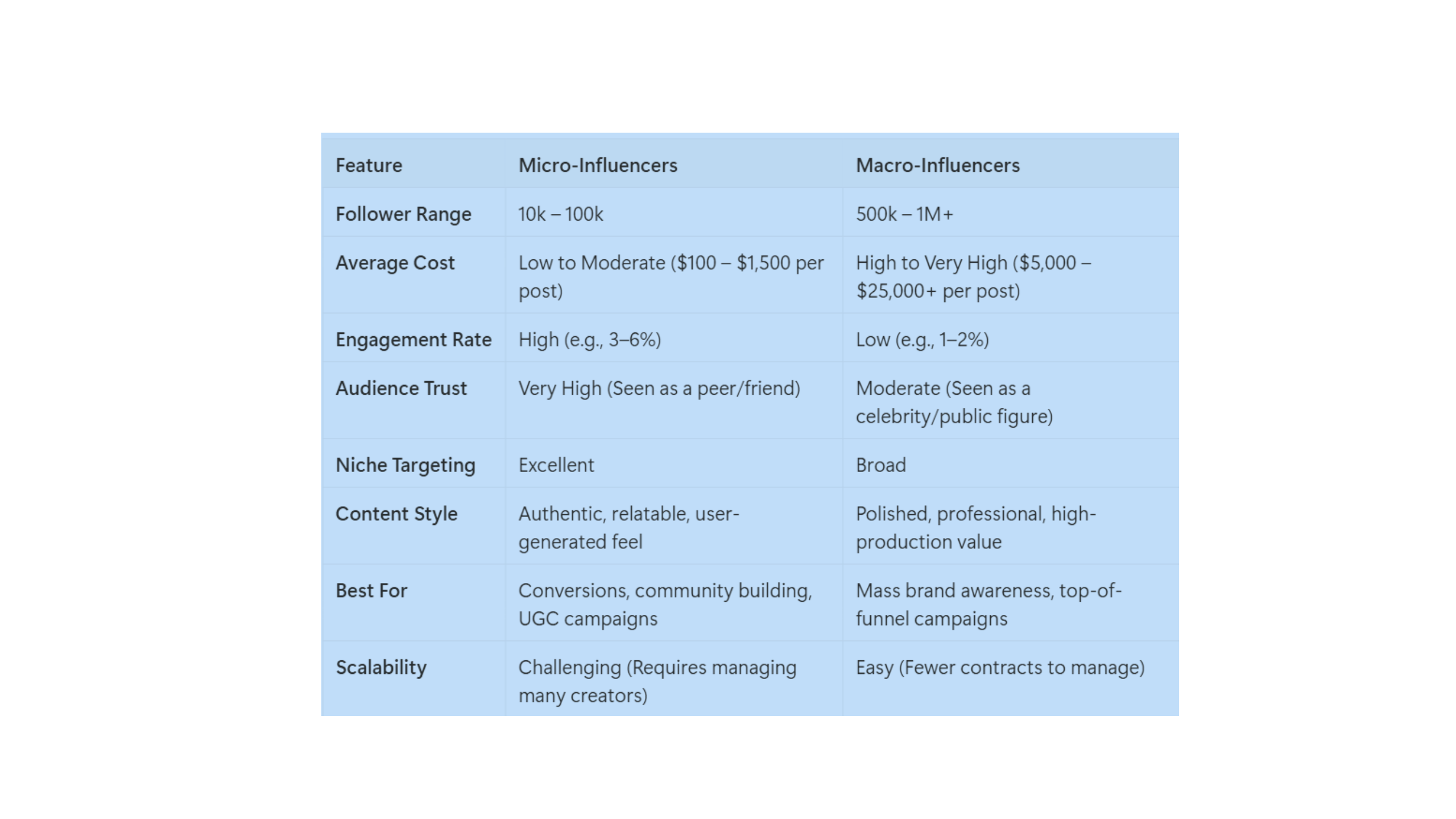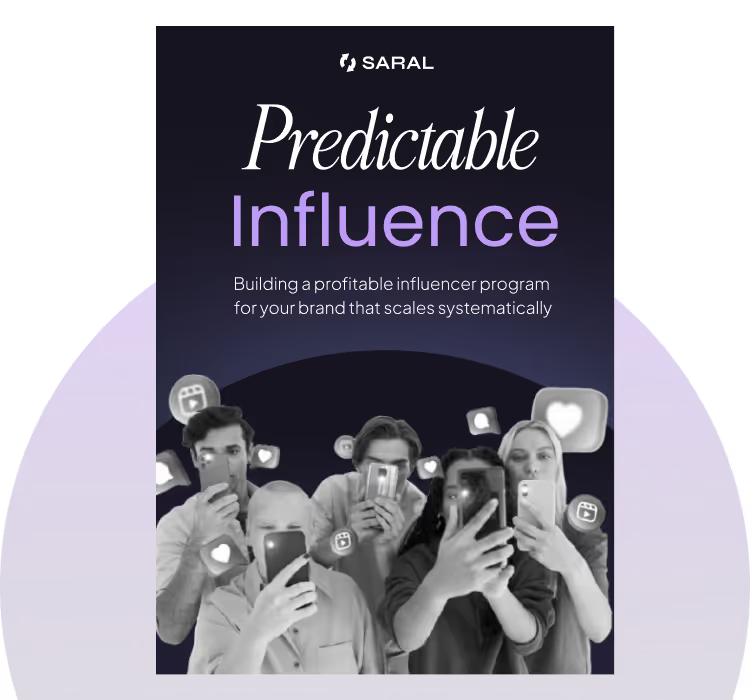Ready to drive incremental growth with influencers?
If ditching the randomness of influencer campaigns and building a predictable, ROI-first influencer program sounds like a plan. Consider talking to our team!

Influencer Marketing
This article compares micro-influencers and macro-influencers, highlighting their unique strengths, audience reach, and impact on brand engagement.
Contents
Allocating your influencer marketing budget is no small decision. With tighter margins and rising customer acquisition costs in 2025, choosing the right type of influencer can mean the difference between a wasted spend and a revenue-driving campaign.
You’re faced with two clear contenders:
Both bring unique strengths to the table, but which is truly right for your brand’s goals, resources, and growth stage?
In this article, you’ll get:
Let’s break down the hype and get to what works so you can invest smarter and scale your brand’s impact in the creator economy.
When planning your next influencer campaign, understanding what micro influencers are and why they’re so effective is essential.
Follower Count:
Micro-influencers typically have between 10,000 and 100,000 followers. This range can vary slightly by platform and region, but it’s widely accepted as the sweet spot for micro status.
Key Characteristics:
Micro-influencers are best described as “everyday experts”. They often specialize in specific niches such as:
Because of this narrow focus, they’re seen as peers or relatable authorities rather than distant celebrities.
Audience Relationship:
Here lies their greatest strength. Micro-influencers maintain:
Key takeaway: Micro-influencers thrive on relatability. Their power isn’t in reaching millions but in deeply influencing thousands within a targeted community.
While micro-influencers excel in targeted community impact, macro-influencers bring a different strategic advantage: large-scale visibility.
Follower Count:
Macro-influencers typically have between 500,000 and 1,000,000+ followers. They sit between micro-influencers and mega-celebrities, offering substantial reach without the extreme cost of top-tier talent.
Key Characteristics:
Macro-influencers are often:
Their content is highly polished, produced at scale, and designed to attract wide attention across multiple demographics.
Audience Relationship:
Unlike micro-influencers, macro-influencers communicate in more of a “broadcast style.” This means:
Key takeaway: Macro-influencers excel at driving awareness at scale. If your goal is mass brand recognition or reaching new markets quickly, they can be powerful partners – but their influence tends to be broad rather than deeply personal.
Choosing between micro and macro influencers comes down to your campaign goals, budget, and operational capacity. Here’s a clear comparison to guide your decision:
When choosing micro vs. macro, factor in operational capacity. Superside highlights that treating influencer work as a program, not a one-off, improves consistency, while external social media creative help can maintain cadence if in-house resources are limited.

Key takeaway: Micro-influencers excel in trust and niche conversions, while macro-influencers win in reach and streamlined management.
If you’re aiming for meaningful impact without blowing your budget, working with micro influencers could be your smartest move. Here are five reasons why brands in 2025 are doubling down on micro collaborations.
Micro-influencers consistently deliver higher engagement rates compared to their macro counterparts. Why?
Example: A sustainable skincare brand partners with five micro-influencers (each with 20k followers). Each post garners ~800-1,200 engaged interactions, driving traffic and conversions more efficiently than a single macro-influencer campaign.
One of the biggest benefits of micro influencers is authenticity. Followers view them as:
This trust translates directly into actionable influence, whether that’s a website visit, app download, or direct purchase.
Micro-influencers thrive in specific niches such as:
Their focused content attracts highly qualified audiences, making your campaign more precise and cost-efficient than casting a broad net.
Compared to macro-influencers, micro-influencers:
This makes them ideal for startups and DTC brands looking to stretch budgets without sacrificing impact.
Because micro-influencers produce authentic, relatable content, brands can:
Example: A home fitness brand uses micro-influencer Reels as social proof in paid ads, driving down CPMs with organic-feel creatives.
Key takeaway: Micro-influencers deliver engagement, authenticity, niche targeting, and superior ROI – plus a steady stream of relatable content to fuel your marketing engine.
While micro-influencers excel in trust and niche conversions, there are strategic scenarios where macro-influencers deliver unmatched value. Here’s when investing in their mass reach makes business sense.
If your goal is maximum exposure fast, macro-influencers are your shortcut:
Example: A fintech startup launching a new payment app partners with a macro-influencer in the personal finance space, achieving over 1 million views and driving top-of-funnel awareness within days.
Macro-influencers are ideal for:
Their broad reach ensures your message penetrates multiple segments simultaneously, creating urgency and widespread conversation.
Partnering with macro-influencers can elevate your brand’s perceived status. Why?
Example: An emerging beauty brand collaborates with a top skincare macro-influencer, positioning itself alongside established products and building consumer trust rapidly.
Macro-influencers are often:
This ensures your campaign assets look polished and align seamlessly with larger brand initiatives.
Key takeaway: Macro-influencers are worth the investment when your strategy demands mass reach, instant credibility, and premium content quality for high-impact campaigns.
Choosing between micro and macro influencers doesn’t have to be guesswork. Use this simple, strategic framework to align your decision with your brand’s goals, budget, and operational capacity.
Ask yourself: What is the primary objective of this campaign?
Example: Launching a new DTC skincare line? Micro-influencers will drive authentic reviews and purchases. Rebranding your entire company? A macro-influencer creates instant top-of-funnel buzz.
Evaluate your available budget honestly.
Tip: Factor in not just the influencer fee, but also content repurposing rights, paid media boosting, and management time when budgeting.
Finally, consider operational realities:
Key takeaway: Your team’s capacity to negotiate contracts, coordinate briefs, and approve content will directly impact campaign success. Choose the model your team can execute confidently.
If you’re ready to harness the power of micro-influencers, scaling efficiently is crucial. Here’s how to master working with micro influencers without overwhelming your team.
1. Leverage influencer platforms.
Tools like SARAL, allow you to filter by niche, location, engagement rate, and audience demographics quickly.
2. Look beyond follower count.
Assess:
3. Conduct manual vetting.
Always review recent posts, Stories, and captions to gauge authenticity and professionalism before outreach.
Pro tip: Save time by building an internal database of vetted micro-influencers for future campaigns.
1. Personalize outreach.
Micro-influencers value authentic connections. Reference specific posts or why you admire their content in your first message.
2. Standardize your offers.
Prepare clear briefs outlining:
3. Batch your outreach.
Send outreach emails or DMs in daily or weekly batches to manage responses systematically without flooding your inbox.
Example: A wellness brand targets 30 micro-influencers weekly, converting 10-15 partnerships at a sustainable operational pace.
1. Product seeding logistics.
Track shipments meticulously to ensure timely delivery before content deadlines. Use tools like Shopify apps or Airtable to manage inventory and shipment status.
2. Simplify contracts.
Use a standard micro-influencer agreement template covering:
3. Streamline payments.
Leverage payout tools (e.g. Deel, PayPal Mass Pay) or your influencer platform’s integrated payments to reduce admin time.
Key takeaway: Systematizing outreach, seeding, contracting, and payment processes is essential to working with micro influencers at scale without bottlenecks.
At the end of the day, choosing between micro and macro influencers isn’t about which is “better” – it’s about which aligns with your brand’s specific goals, budget, and team capacity.
Here’s the core takeaway:
But the most sophisticated brands in 2025 aren’t choosing just one.
Leading brands combine both tiers strategically:
Key takeaway:
Micro vs macro influencers isn’t an either-or decision. Integrate both to maximize reach, trust, and ROI across your influencer marketing strategy.
Ready to build your hybrid influencer strategy? Explore our upcoming guide on “Structuring Always-On Micro-Influencer Campaigns” to start implementing this approach effectively.
1. Can I work with micro-influencers if I don't have a big budget?
Yes. Many micro-influencers are open to “gifting” campaigns, where they receive free products in exchange for consideration or content creation. Others charge very affordable rates (often $100 – $300 per post), making them ideal partners for startups and small businesses looking to build credibility without heavy upfront spend.
2. Is it better to work with one macro-influencer or 100 micro-influencers?
It depends on your goals and operational capacity.
Key takeaway: If your priority is broad awareness with operational simplicity, go macro. If your priority is conversions, content, and cost-efficiency, micro-influencer fleets win.
3. How do I measure the success of a micro-influencer campaign?
Track these key metrics:
4. Are Nano-influencers (under 10K followers) also a good option?
Absolutely. Nano-influencers offer the highest level of authenticity and relatability. Their small, loyal followings trust them deeply, making them:

Sign up for a 7-day email course on the unique "Predictable Influence" strategy used by top brands like Grüns, Obvi, Tabs Chocolate.

If ditching the randomness of influencer campaigns and building a predictable, ROI-first influencer program sounds like a plan. Consider talking to our team!